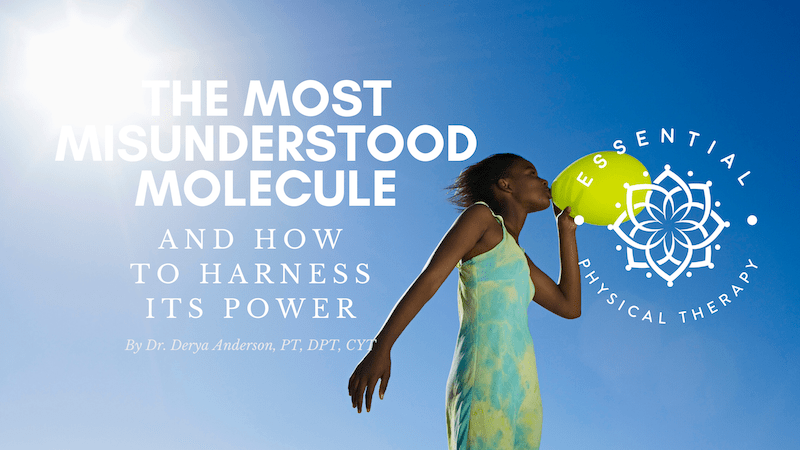Deeper, quieter, regular, slower.
Those are the general guidelines for focusing our attention on the breath. This awareness makes us feel calmer, more relaxed, and releases tension from our bodies.
But How? Why does changing our breath change our mood, and many other factors?
Research has shown that slower, deeper breathing reduces heart rate and risk for cardiovascular disease, as well as improves athletic performance. (yes, all you athletes out there, breathe slower to go faster).
The reason all these magnificent changes occur within us when we deepen our breath, especially our exhales, is because of a very special molecule that usually gets a bad rap.
I’m talking about good old carbon dioxide, CO2.
I know what you’re thinking…is she talking about the very same carbon dioxide that we are trying to reduce in our atmosphere to slow global warming? The same carbon dioxide that is considered a waste product of our bodies- something useless to to be rid of as soon as possible?
Well, yes, I am.
But what if I told you that this special little molecule was not only a useful component in improving your health, but an essential one for you to be able to thrive?
You see, for our bodies to get oxygen from our lungs to our tissues, we need carbon dioxide. To get a proper inhale, our receptors in our neck need to sense a certain amount of carbon dioxide in our bodies.
Not to mention, carbon dioxide is stored as bicarbonate in your blood stream, which is essential for maintaining the pH balance of your whole body.
Did I mention that carbon dioxide is critical in weight loss? Most of your body mass lost is due to breathing out carbon dioxide. In fact, more than 80% of weight loss is due to breathing out CO2, and only 15% or so is lost via sweat and urine.
So, if you’ve been dieting, exercising, doing all the right things and still not losing weight… you may want to look at how you’re breathing.
Let’s explore some of these in a little detail…
Firstly, how the heck does carbon dioxide help your body get more oxygen?
Think of carbon dioxide as the Fedex guy, and oxygen as your packages. When outside air hits your lungs, it makes it’s way down to alveoli, the tiny air sacs that interface with the blood stream. The oxygen molecules (packages) get loaded from the alveoli onto the red blood cell, which in this analogy is the Fedex truck.
The truck travels all over the body, delivering oxygen to all the cells as they all need oxygen to survive and flourish. When exercising, certain muscles need even more oxygen more quickly.
This is where our good buddy carbon dioxide comes in.
Oxygen cannot get off the truck unless there is a carbon dioxide molecule there to unload it.
When the oxygen gets to its destination, the carbon dioxide triggers the packages (oxygen) to be unloaded off the Fedex Truck (red blood cell), and be delivered to the cells (your mailbox).
The more carbon dioxide present, the more efficiently the oxygen can be offloaded to cells.
So, when you’re exercising and you really need to get oxygen to those tissues, perhaps try breathing slower instead of faster.
Why does the amount of CO2 in your body determine how you inhale?
I’m constantly telling my patients, don’t worry about the inhale! If you get a good exhale, the inhale will just come.
This is for two reasons, the first of which is purely mechanical.
When you exhale completely, the lungs become essentially “empty” of air, which creates a vacuum. New air has to flow in. It must follow the laws of nature! It must flow from the higher pressure (outside your body) to the lower pressure (inside your lungs). You don’t have to use your accessory muscles (aka your neck) to pull air in, it just goes in! Easy.
The second reason is neurological.
Deep in the reptilian brain, the most primal part of our brain that was present when the first creature crawled out of the primordial goo and decided to walk on land, there is a simple neural network that says, “breathe.”
This network senses levels of oxygen and CO2 in your body to decide when to inhale or exhale. Basically, when your body senses a certain level of oxygen in your body, that circuit makes you exhale. Similarly, when a certain level of CO2 is sensed, the circuit makes your body inhale.
Unfortunately, for many of us, this circuit gets messed up.
We breathe shallowly because we are less active, or stressed, or both, and we do this so much that we end up overriding the part of the circuit that senses CO2 and tells you to inhale.
We get stuck in this cycle of inhaling without ever getting to the bottom of our breath; we lose that primal trigger to inhale, so our inhales get all wonky, a.k.a. you end up pulling your ribcage up with your neck.
In addition to all these important factors, carbon dioxide is the main reason that you feel relaxed with deeper breathing.
Carbon dioxide makes you chill out.
Think about it. What do they tell you to do when you’re having a panic attack? Breathe into a paper bag. You’re breathing back in the CO2 you exhaled. Get that CO2 flowin’ baby!
Carbon dioxide relaxes you by causing your blood vessels to relax, which allows blood to deliver oxygen to all your tissues more easily.
Also, as mentioned above, CO2 lets your body unload oxygen from red blood cells to tissues.
These two factors together mean that your brain gets more oxygen and blood flow. This tells your body that you are safe, and you feel calmer and, well, more chill!
So how to insure that you get more CO2, but not too much?
The answer is simple, and I think you know what I’m going to say.
Breathe deeper, quieter, regular, slower.
5-6 seconds for each inhale and exhale, resulting in about 5-6 breaths per minute, is the ideal for balancing the CO2 and O2 in your body.
Below is a short video on how to do just that and harness the power of this special molecule.
Are you ready to breathe better to move better, to improve the health and resiliency of your lungs without any medication or procedures? Click the button below to find out if will benefit from working with Dr. Derya.
References
Aakash K. Patel; Andrew Benner; Jeffrey S. Cooper. Physiology, Bohr Effect.
https://www.ncbi.nlm.nih.gov/books/NBK526028/
Anders Olsson Blog https://www.consciousbreathing.com/anders-olsson/carbon-dioxide-training-extremely-harmonious/
Nestor, James. Breath: The New Science of a Lost Art. May 14, 2020 http://www.pathwaymedicine.org/control-of-respiration









